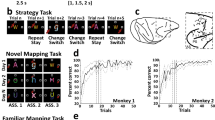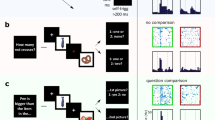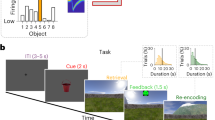Abstract
MOST of our long-term memories of episodes or objects are organized so that we can retrieve them by association. Clinical neuropsychologists assess human memory by the paired-associate learning test, in which a series of paired words or figures is presented and the subject is then asked to retrieve the other pair member associated with each cue1. Patients with lesions of the temporal lobe show marked impairment in this test2–6. In our study, we trained monkeys in a pair-association task7 using a set of computer-generated paired patterns. We found two types of task-related neurons in the anterior temporal cortex. One type selectively responded to both pictures of the paired associates. The other type, which had the strongest response to one picture during the cue presentation, exhibited increasing activity during the delay period when the associate of that picture was used as a cue. These results provide new evidence that single neurons acquire selectivity for visual patterns through associative learning. They also indicate neural mechanisms for storage and retrieval in the long-term memory of paired associates.
This is a preview of subscription content, access via your institution
Access options
Subscribe to this journal
Receive 51 print issues and online access
$199.00 per year
only $3.90 per issue
Buy this article
- Purchase on Springer Link
- Instant access to full article PDF
Prices may be subject to local taxes which are calculated during checkout
Similar content being viewed by others
References
Wechsler, D. Wechsler Memory Scale-Revised (The Psychological Corporation, Harcourt Brace Jovanovich, San Antonio, 1987).
Meyer, V. & Yates, A. J. J. Neurol. Neurosurg. Psychiat. 18, 44–52 (1955).
Milner, B. Brain Mechanisms Underlying Speech and Language, 122–145 (Grune & Stratton, New York, 1967).
Jones, M. K. Neuropsychologia 12, 21–30 (1974).
Petrides, M. Neuropsychologia 23, 601–614 (1985).
Goldstein, L. H., Canavan, A. G. M. & Polkey, C. E. Cortex 24, 41–52 (1988).
Murray, E. A., Gaffan, D. & Mishkin, M. Soc. Neurosci. Abstr. 14, 2 (1988).
Miyashita, Y. & Chang, H. S. Nature 331, 68–70 (1988).
Miyashita, Y. Nature 335, 817–820 (1988).
Snedecor, G. W. & Cochran, W. G. Statistical Methods 8th edn, 97 (Iowa State University Press, Ames, 1989).
Perrett, D. I., Rolls, E. T. & Caan, W. Expl Brain Res. 47, 329–342 (1982).
Desimone, R., Albright, T. D., Gross, C. G. & Bruce, C. J. Neurosci. 4, 2051–2062 (1984).
Schwartz, E. L., Desimone, R., Albright, T. D. & Gross, C. G. Proc. natn. Acad. Sci. U.S.A. 80, 5776–5778 (1983).
Artola, A. & Singer, W. Nature 330, 649–652 (1987).
Frégnac, Y., Shulz, D., Thorpe, S. & Bienenstock, E. Nature 333, 367–370 (1988).
Bruce, C. J. & Goldberg, M. E. J. Neurophysiol. 53, 603–635 (1985).
Mauritz, K.-H. & Wise, S. P. Expl Brain Res. 61, 229–244 (1986).
Funahashi, S., Bruce, C. J. & Goldman-Rakic, P. S. J. Neurophysiol. 61, 331–349 (1989).
Milner, B. Clin. Neurosurg 19, 421–446 (1972).
Squire, L. R., Cohen, N. J. & Nadel, L. Memory Consolidation: Psychobiology of Cognition, 185–210 (Lawrence Erlbaum, Hillsdale, 1984).
Insausti, R., Amaral, D. G. & Cowan, W. M. J. comp. Neurol. 264, 356–395 (1987).
Webster, M. J., Ungerleider, L. G. & Bachevalier, J. J. Neurosci. 11, 1095–1116 (1991).
Zahn, C. T. & Roskies, R. Z. IEEE Trans. Comput. 21, 269–281 (1972).
Rolls, E. T. et al. J. Neurosci. 9, 1835–1845 (1989).
Gross, C. G., Rocha-Miranda, C. E. & Bender, D. B. J. Neurophysiol. 35, 96–111 (1972).
Author information
Authors and Affiliations
Rights and permissions
About this article
Cite this article
Sakai, K., Miyashita, Y. Neural organization for the long-term memory of paired associates. Nature 354, 152–155 (1991). https://doi.org/10.1038/354152a0
Received:
Accepted:
Issue Date:
DOI: https://doi.org/10.1038/354152a0
This article is cited by
-
Local features drive identity responses in macaque anterior face patches
Nature Communications (2022)
-
Neural signature of the perceptual decision in the neural population responses of the inferior temporal cortex
Scientific Reports (2022)
-
Dynamic branching in a neural network model for probabilistic prediction of sequences
Journal of Computational Neuroscience (2022)
-
Mouse visual cortex areas represent perceptual and semantic features of learned visual categories
Nature Neuroscience (2021)
-
Rotational dynamics reduce interference between sensory and memory representations
Nature Neuroscience (2021)
Comments
By submitting a comment you agree to abide by our Terms and Community Guidelines. If you find something abusive or that does not comply with our terms or guidelines please flag it as inappropriate.



